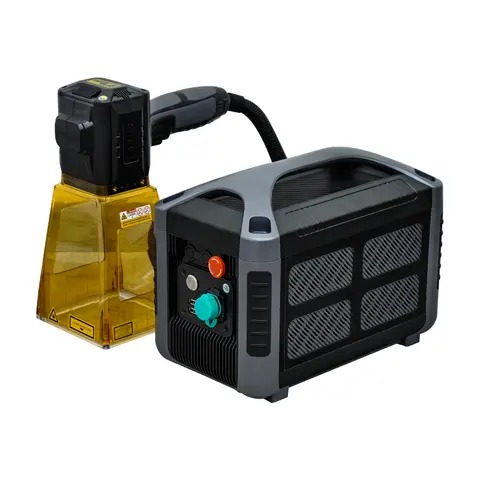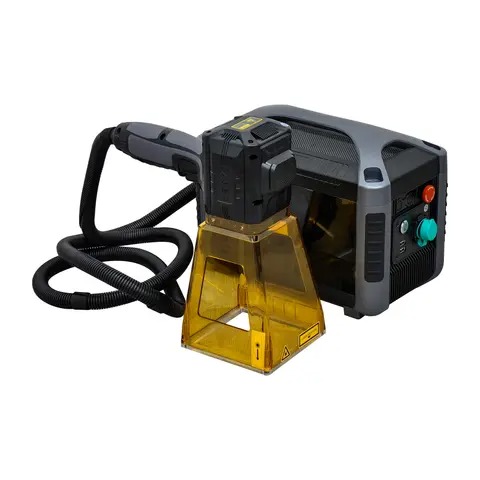Views: 199 Author: Site Editor Publish Time: 2025-07-25 Origin: Site
A laser marking machine is a powerful tool widely used in industrial, commercial, and even medical fields for etching, engraving, or marking information onto the surface of various materials. Whether it's a serial number, barcode, QR code, or logo, laser marking ensures long-lasting, high-precision identification that resists wear, heat, and corrosion. However, as robust as these markings are, there are instances where removal becomes necessary. This might be due to rebranding, correction of errors, recycling of parts, or compliance with evolving regulations.
Removing a laser marking isn't as simple as wiping away ink or paint. These markings are often deeply embedded into the surface structure of metals, plastics, ceramics, or glass. Understanding how to remove laser markings effectively—without damaging the substrate—is a process that involves not only technical knowledge but also the right tools and safety practices.
This article explores the various methods used to remove laser markings, their advantages and limitations, and the factors to consider before beginning the removal process. It is designed to help engineers, operators, and quality control professionals make informed decisions when working with laser-marked components.
Laser markings are designed to be permanent and resistant to physical and chemical degradation. So why would anyone want to remove them? Here are the most common reasons:
Rebranding or Reuse: Companies may want to rebrand components or repurpose materials already marked for previous usage.
Correction of Errors: Mistakes in the laser-marked content (e.g., incorrect serial number) require removal and re-marking.
Compliance Requirements: Changes in regulatory requirements might make it necessary to remove or modify existing laser markings.
Product Aesthetics: For visible consumer-facing products, removing or refining the appearance of markings may be necessary for visual consistency.
Prototyping and Testing: During R&D or quality testing, components may be reused multiple times, necessitating removal of old markings before new ones are added.
Understanding the reason behind the removal will help determine which method is best. For example, aesthetic refinement on stainless steel would require a more delicate process than removing a deep-etched mark on a hardened alloy used in aerospace components.

Laser marking removal techniques vary based on the substrate material, depth of engraving, and the desired finish after removal. Below are the most commonly used techniques:
Abrasive blasting involves propelling fine particles (such as aluminum oxide, glass beads, or sand) at high speed to erode the laser marking from the surface. This method is effective for metal components where cosmetic appearance is secondary.
Pros:
Effective for deep and durable marks
Fast and scalable for bulk parts
Cons:
May damage or alter the base material
Not suitable for thin or delicate surfaces
Use Case: Removing laser-etched serial numbers from industrial steel parts for reuse.
This process uses rotary tools, polishing wheels, or fine-grit sandpaper to physically grind off the top layer of material until the marking is no longer visible. It is labor-intensive but offers control over the amount of material removed.
Pros:
Inexpensive and accessible
Precise control over removal depth
Cons:
Labor-intensive and time-consuming
Risk of uneven surface finish
Use Case: Fine polishing on aluminum parts for consumer electronics where smooth finish is crucial.
Ironically, another laser marking machine—set at a different wavelength or intensity—can be used to remove previous laser marks. Known as laser ablation, this non-contact technique vaporizes the surface layer without damaging the substrate.
Pros:
Highly precise and non-invasive
Excellent for high-value or delicate materials
Cons:
Requires expensive specialized equipment
Needs skilled operators to fine-tune settings
Use Case: Removing intricate laser patterns from high-end medical implants or aerospace parts.
In cases where the laser marking has altered the chemical composition of the surface (especially with oxidation or color-changing techniques), certain acids or solvents may help fade or erase the mark. This method is rarely used alone but can complement mechanical methods.
Pros:
Minimal physical abrasion
Can reach into micro-etched areas
Cons:
Hazardous chemicals may require special handling
Limited success on deep or dark marks
Use Case: Surface cleaning of anodized aluminum panels used in lab environments.
Not all laser markings are created equal. Before attempting removal, consider the following factors to avoid unintended damage or compliance issues:
| Factor | Details |
|---|---|
| Material Type | Is the component made of metal, plastic, ceramic, or composite? |
| Marking Depth | Surface-level or deep engravings require different removal intensities. |
| Surface Finish | Will removal impact aesthetics or functionality of the part? |
| Re-marking Required? | If you plan to re-mark, avoid techniques that warp or weaken the surface. |
| Safety Regulations | Are there risks of chemical exposure or particulate inhalation? |
| Cost and Speed | Is this a one-time process or part of a batch production workflow? |
Carefully assessing these factors will ensure you select a technique that aligns with the quality, safety, and production requirements of your specific application.

Not always. Some laser markings—especially deep engravings or those on brittle materials—may leave a residual shadow or texture, even after mechanical or chemical removal. The goal should be minimizing visibility while preserving the integrity of the material.
Yes, but only if it's configured appropriately. Traditional laser engravers won't remove markings effectively unless optimized for cleaning mode, usually involving higher pulse frequency and lower energy density.
It can, especially if aggressive methods like grinding or blasting are used. Laser cleaning and chemical etching tend to be less invasive. Always conduct a test on a non-critical area first.
It depends on the method and material. Laser cleaning may take a few seconds per mark, while mechanical polishing might take several minutes.
No. Plastics are sensitive to heat and abrasion. Laser ablation and certain solvents may be more suitable, but mechanical methods often deform or discolor plastic surfaces.
Working with laser marking machine removal—especially with lasers, chemicals, or abrasives—comes with its own set of risks. Here are some industry-standard best practices:
Wear Protective Equipment: Safety goggles, gloves, and respiratory masks are essential when dealing with dust or fumes.
Use Fume Extractors: Especially during laser ablation or chemical etching, to avoid inhaling harmful byproducts.
Secure the Workpiece: Prevent movement that could cause tool slippage or inconsistent removal.
Inspect the Result: Use magnification tools or surface finish testers to ensure that the marking has been completely removed and the surface integrity preserved.
Keep Documentation: Especially in regulated industries, maintain logs of removal processes, tools used, and personnel involved.
By incorporating these practices, businesses not only protect their workers but also enhance the repeatability and efficiency of their processes.
Removing laser markings is not simply about erasing a visual feature; it's a delicate balance between technical accuracy, material preservation, and process efficiency. Whether you're dealing with stainless steel machinery parts or lightweight composite enclosures, choosing the right method is critical to avoid costly damage or non-compliance with quality standards.
While abrasive blasting and mechanical grinding provide brute-force solutions for industrial-grade materials, laser cleaning emerges as the most precise and material-friendly option, especially when high-value components are involved. At the same time, understanding the properties of the substrate and marking depth is essential before selecting a method.
Ultimately, successful laser marking removal combines technical expertise with practical execution—an interplay of science, safety, and strategic decision-making. With the right tools and knowledge, you can efficiently handle any scenario that requires the careful undoing of what a laser marking machine has so precisely etched.